The post 7 tools to monitor your competitors’ traffic appeared first on Inside Social Media.
]]>
“Heavy Traffic” by Masakazu “Matto” Matsumoto on Flickr
Just how accurate are Alexa, Compete, Quantcast & the others?
This is part of our ongoing series on website optimization and traffic analysis.
Guest post by Sam Crocker
SEOmoz
Today we’re going to examine a number of tools and resources for getting insights into competitors’ traffic data. We’ll assess their strengths and weaknesses as well as the validity and usefulness of the data provided.
We’ve had clients asking us for a better view of overall market size and what kind of traffic their competitors are getting, since it can be tricky to find meaningful predictive data even when you know who your competitors are or should be.
It is worth pointing out that a number of these services suggest they can provide better data if you claim the sites by entering your ownership credentials. I can’t testify to the accuracy of this, and our analysis is based upon the free version of the tools as we did not have paid access to any of the tools.
We tested 25 sites for which we had reliable internal data, giving us insight into just how accurate these tools really are — or aren’t.

Alexa: Too often, dubious numbers
1Strengths: Alexa is good for comparing different sites traffic and for monitoring general traffic trends. It can be quite useful for comparing one site to a competitor site (up to five sites at a time). The index is massive and contains some data about all of the 25 sites we tested.
Weaknesses: Not so great for the smaller sites. As you can see below, you won’t get any of the traffic charts for sites ranked outside of the top 100,000, which means if Alexa thinks you are getting fewer than 10,000 visits per month you’re unlikely to glean any great information. Accuracy is a serious concern. This does call into question the usefulness of the tool in general. The numbers reported are not helpful for predicting traffic on their own.
Accuracy: We want to keep this all anonymous but let’s just say one site that we know gets 10-20,000 visits per month had an Alexa rank that was more than five times better than a site that we know gets 75,000+ visitors per month. And this was not just a one-off event. So I have to seriously question the reliability of this tool. It didn’t seem to be too bad at predicting the trends for a single site but the charts are extremely difficult to make any real use of. Interestingly it seems to be skewed in favor of sites within the search marketing space. Sites in the search marketing space that we looked at regularly outranked sites receiving more than 10 times as much traffic on a monthly basis.
How to best use Alexa: The tool is interesting for comparing similar sites or sites within an industry, but be very cautious about using this to make any meaningful suggestions or estimates on traffic data. The most accurate data seemed to be the data from the visitors by country — the percentages we looked at were not too far off.
Cost: Free. Options for site audits for $199.
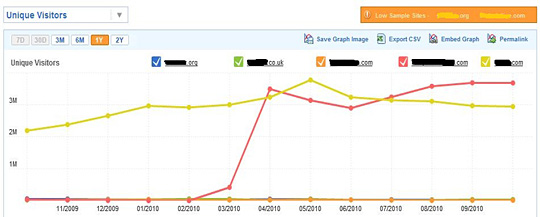
Compete: Good UI, questionable data
2Strengths: Compete has a useful interface, speaks the right language (unique visitors, visits, etc.), offers the ability to compare multiple sites, and its data is easy to understand and well presented.
Weaknesses: Accuracy, somewhat limited number of sites – many sites that it classifies as “low sample sites,” and the cost of the Pro option.
Accuracy: Again, accuracy is a serious concern here. The data was off in some cases by as much as 2,000% for monthly visits. The accuracy seemed to be a bit better for the peaks in traffic and some of the general trends we looked at but was certainly not reliable enough for us to suggest reporting competitor traffic based upon this information.
How to best use Compete: It should come as no surprise that Compete is best used for comparing competitors. The scale of the data is way off but some of the trends seemed to be fairly reliable. I wouldn’t advise reporting any numbers from this data as they do not seem close/reliable at all – often off by a factor of 200% or more — however the trends are reliable. The information could be meaningfully used to look into seasonal trends between competitors.
Cost: Free. The Pro membership is $499 per month.
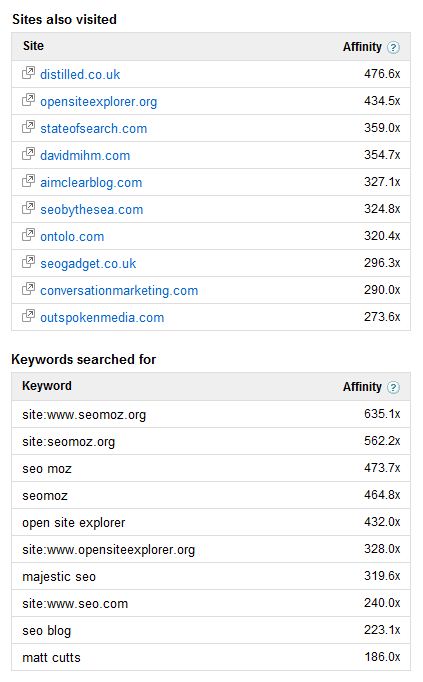
Google Ad Planner: Some unique twists
3Strengths: Google Ad Planner has a few things going for it: Its “sites also visited” data is good, the keywords searched for can be quite valuable, and the “audience interests” data is interesting.
Weaknesses:: Accuracy, lack of data for small sites.
Accuracy: The accuracy was really mixed. For many of the sites AdPlanner provided much better data than some of the others. However, they were still off by miles for some sites – off by as much as 1000%. Given the occasional “big miss,” I would not be comfortable using this data to make traffic predictions for a client.
How to best use Google Ad Planner: The data about other sites visited as well as keywords searched for (with affinity) could be extremely valuable as well as some of the other metrics reported on and audience interests. However, the traffic data is not particularly meaningful and can’t be relied upon.
Cost: Free.
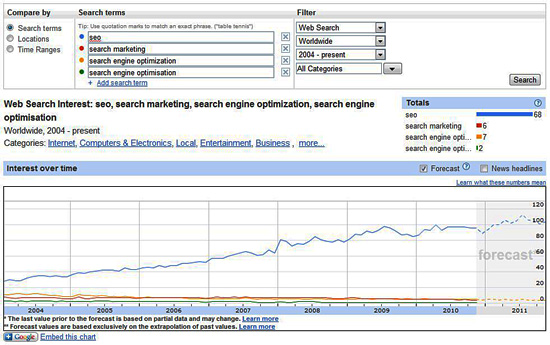
Google Insights: Numbers normalized for search
4Strengths: Google Insights offers generalized trends around key phrases and key phrase groups and regional information. Trusted source.
Weaknesses: It was difficult to read the data. There were no hard numbers about traffic. It was hard to compare entire sites to one another.
Accuracy: You can bet that the accuracy of this data is going to be pretty good given that the data provider has access to more data than anyone else on the Internet. However, the fact that the numbers are normalized and more designed for key phrases and search terms and trends than for traffic data means that the search volume will correspond perfectly with the traffic to a site.
How to best use Google Insights: The tool could be quite helpful for finding the most valuable pockets of key phrases and key phrase groups. This could be particularly valuable when looking at a competitor site and trying to figure out which of their key phrases are driving the most traffic. It could help you see which of the key phrases within a key phrase group might be the most valuable.
Cost: Free.
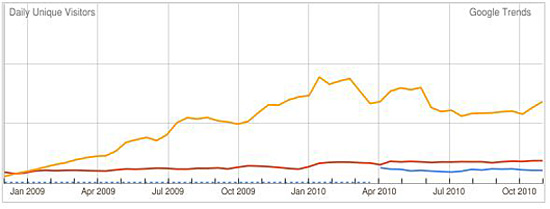
Google Trends: For broad information gathering
5Strengths: Google Trends for Websites is good for illustrating magnitudes of difference between sites. It allows comparison of multiple websites, and it includes regional information.
Weaknesses: It’s not good for comparing sites fairly similar in size. It does not provide information for smaller sites when logged in, it’s accuracy is uneven and it provides no numbers.
Accuracy: The data seem to be more accurate when only trying to compare traffic from search; it does not seem to do as well in assessing overall traffic. When comparing websites with drastically different traffic numbers, the rough visual estimation appears to correspond quite well with the observed analytics data as well. When visiting the site and logged in, Trends it does provide numbers and ranges, though the data looks to be off on a few of the sites I have checked. It is not as far off as the data for the same sites using AdPlanner, but still considerably far off — e.g., reporting 140,000 visits for a site that receives about 320,000 unique visits daily.
How to best use Google Trends for Websites: Trends is great for broad information gathering. It gives some insight into similar searches when comparing sites, and in general it is unlikely that you will find better comparative data out there without direct access to your competitor’s analytics account. However, Trends does not provide numbers and thus can only be used to venture a guess at what sorts of numbers competitors are pulling in.
Cost: Free.

Quantcast: Nifty Media Planner Tool
6Strengths: Quantcast provides traffic numbers that are easy to follow, displays information nicely, offers some demographic information and has an interesting Media Planner Tool.
Weaknesses: Unreliable and often inaccurate, lacks data for small and medium trafficked sites. Inability to compare sites.
Accuracy: The biggest shortcoming of the Quantcast data is accuracy. As with some of the other services, the traffic data is estimated and is nowhere near accurate on the sites for which Quantcast had any data. Data was off by as much as 10 times the actual analytics data for some of the sites.
How to best use Quantcast: Although the data is not particularly reliable for the traffic data, some of the other tools the site has to offer seem quite interesting and worth further investigation. The demographics information provides a reference as to how the data compare against Internet averages.
Cost: Free.
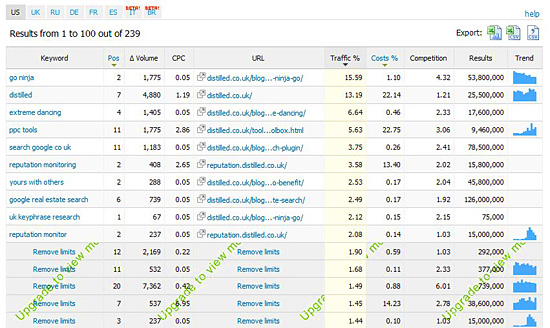
SEMrush: Most accurate of the bunch
7Strengths: SEMrush‘s data includes sites of all sizes, a list of key phrases and rankings for those terms — and provided the most accurate data of all the tools we examined.
Weaknesses: The data were still imperfect. Customers must pay to get full data lists. And the data is only for Google traffic.
Accuracy: The data were not perfectly accurate, though generally speaking SEMrush did not miss the mark for any of the sites we tested the way a number of the other tools did. In the end, the data were surprisingly accurate. As with some of the Google data, the information reported is just the Google search engine traffic, but this is our main area of focus and was quite accurate when drilling down into that specific area of traffic within analytics.
How to best use SEMrush: Although imperfect, this tool came the closest to providing accurate data that I would, at least with a word of warning, be willing to share with a client about potential expectations or about where their competitors’ traffic may be. Most importantly, the add-on options and ability to see the keyword lists and how the competitor ranks for these terms is extraordinarily appealing.
Cost: Free to $499 per month. We used the free version.
A look at two final sites that estimate Web traffic
comScore
Unfortunately, we struggled with comScore. We were unable to get a log-in or sneak a peek at any of the data.
How to best use comScore: comScore offers a number of reports and insights into markets, including reports on local market size as well as information about valuable/important keywords in an industry. It would be very interesting to find out where this data was coming from and how good it was, but we were not able to achieve this in time to publish this information.
Cost: Not disclosed.
HitWise
Unfortunately, we were not able to get data from HitWise in time for publication.
How to best use HitWise: HitWise, similarly to comScore, works on a reporting basis insofar as you speak to them about the types of market reports you would like, or you can create custom reports. While we cannot comment on the accuracy of the data, the services offered look to be better tailored to an SEO‘s needs than do the reports offered by comScore. However, generally speaking HitWise will not work with agencies, which will be a bit of a bummer for some of you.
Cost: Free to $695+ per report
Conclusion
I hope that the findings from all this research will be valuable to you. Ultimately, it’s an incomplete study. For the time being I would rely most heavily on SEMrush for predicting traffic and estimating how well a competitor is doing, but all of these tools add something to the ever-growing traffic toolbelt even if it may be for a purpose other than that which I was hoping they would achieve.
SEO & Web traffic articles
• Keywords, search marketing and data mining (Socialmedia.biz)
• Everything you need to know about SEO (Socialmedia.biz)
• The beginner’s checklist for learning SEO (Socialmedia.biz)
• 25 tips to skyrocket your search engine rankings (Socialmedia.biz)
• 14 strategies to grow your blog’s audience (Socialmedia.biz)
• Launching a new site: 18 steps to successful metrics & marketing (Socialmedia.biz)
• Reputation management SEO: 6 advanced tactics (Socialmedia.biz)
• Linkscape Visualization and Comparison tool (SEOmoz)
• Competitive Link Research tools (SEOmoz)
The post 7 tools to monitor your competitors’ traffic appeared first on Inside Social Media.
]]>The post All about metrics and Web analytics appeared first on Inside Social Media.
]]> During the Traveling Geeks trip to the UK I had the good fortune of having a Flip Ultra HD recorder in my pocket when I bumped into Jim Sterne. Jim runs the Emetrics Marketing Optimization Summit and is also chairman of the Web Analytics Association.
During the Traveling Geeks trip to the UK I had the good fortune of having a Flip Ultra HD recorder in my pocket when I bumped into Jim Sterne. Jim runs the Emetrics Marketing Optimization Summit and is also chairman of the Web Analytics Association.
Our interview took place on the third story of the historic Globe Theatre overlooking the Thames during the Econsultancy Roundtable on our last day in London, and the 5-minute video came out fairly well, considering the lack of fill lighting, the lack of a tripod and some audio artifacts from the Flip.
Sterne, head of Target Marketing of Santa Barbara, breaks down analytics into three main buckets:
1Website ratings: What’s happening on the Internet in general? Which websites are the most popular? Popular services include comScore, Nielsen/Netratings, Hitwise as well other tools like Quantcast and Alexa.
2Advertising: The ad industry needs to know how many ads are being served and whether they’re being clicked. Doubleclick is the giant of the field; the Atlas Network, 24/7 Real Media and Right Media are other players.
3Web analytics: At each website, what is the user’s behavior? Are they arriving on the landing page? Do they bounce off (hit one page and go no further)? Can I tweak the persuasion process to improve the conversion rate? What’s their demographic and behavioral makeup? Customer satisfaction and tracking social media traffic also tie into this. Measurement tools and firms include Google Analytics, Omniture, Web Trends and CoreMetrics.
Measuring social media
Sterne said social media can be measured in a number of ways: How often am I (or my company) mentioned? Is that mention positive or negative? Does it drive traffic to my site? Is it qualified, valuable traffic?
Social media play a valuable role in gauging customer satisfaction, he added. People are talking about my brand in positive ways and negative ways, in which case I need to respond by fixing the problem and thanking them for making me aware of it.
Watch or embed the video on Blip.tv
Watch video on Ourmedia.org
Download video from Archive.org
- Alexa gets a big overhaul, offers new stats (inquisitr.com)
The post All about metrics and Web analytics appeared first on Inside Social Media.
]]>






![Reblog this post [with Zemanta]](http://img.zemanta.com/reblog_e.png?x-id=06ef03da-3bbb-4804-b02a-1a347353ba30)